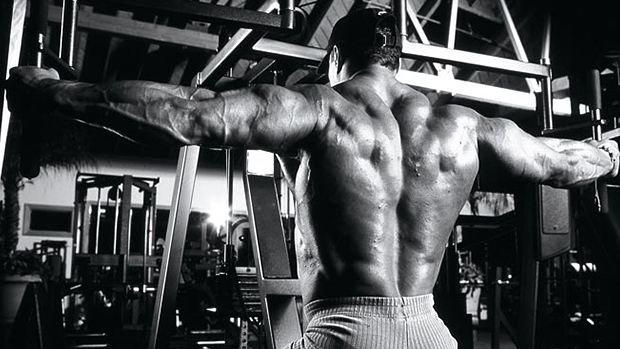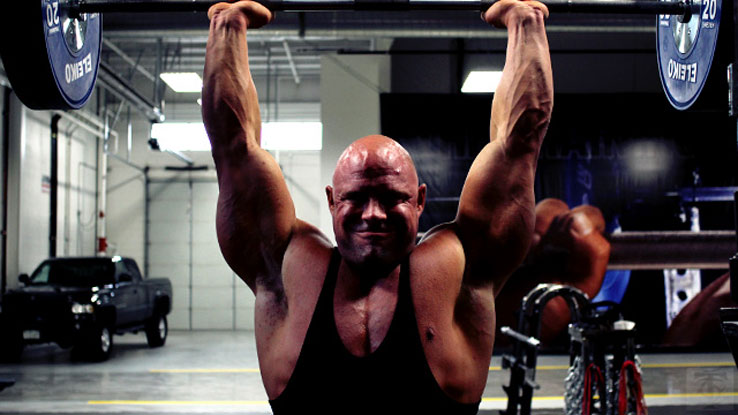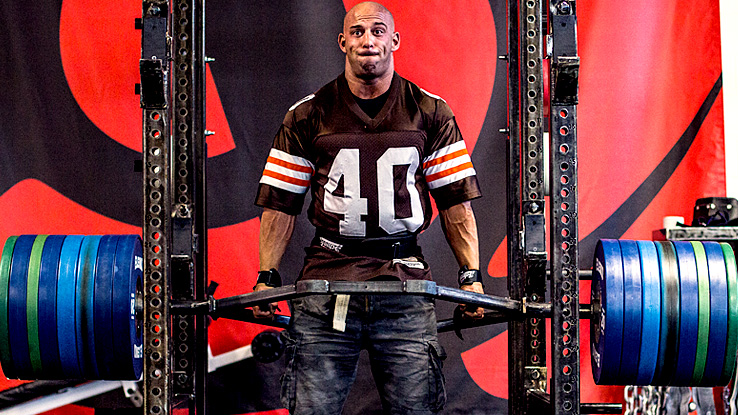Here's what you need to know...
- Standing dumbbell presses work best. They activate the delts more than standing barbell presses or seated versions of either lift.
- Bench-pressing is a delt exercise as much as it is a chest exercise. It's particularly true of incline bench presses.
- Use a specific grip-width when benching to activate the delts. In the decline and flat bench press, use a shoulder-width grip. When pressing above 30 degrees, use the widest grip that doesn't weaken you.
- Don't shun upright rows. While plenty of coaches say to avoid them, doing wide-grip upright rows targets the middle deltoid without bothering your shoulders.
- Use a narrow or neutral grip on pull-ups. It'll maximize posterior delt activation.
Building the shoulders up isn't easy. The deltoids wrap around your shoulder like armor, which means that it's impossible to build muscular thickness from front to back with any one lift.
For Big Delts, Go Heavy and Light
The delts are traditionally described as three muscle heads – anterior, middle, and posterior – but there are really seven individual segments. As for deltoid muscle fiber type, the delts seem to have a mixed fiber type, so training the delts needs to incorporate both heavy loads and lighter loads.
The King of the Deltoid Exercises

For overall muscle activity in all three heads of the delts, there's one exercise that comes out on top, and it's probably not what you would have guessed. Saeterbakken, et al. (2013) investigated four different types of shoulder presses and found that muscle activity was the highest (15% higher) in the standing dumbbell press and not the standing barbell press. So if you only have time for one shoulder exercise, make it the standing dumbbell press.
Punish the Anterior Delts
Bench press, baby.
The bench press produces very high muscle activity in the anterior deltoid, nearly as high as in the pectoralis major (Schick et al. 2010). This is true of horizontal bench presses, but it's particularly true of incline bench presses. Inclines will target both the anterior and middle delts the most. There's no need to get too technical here; just use your strongest bench angle above 30 degrees and use the widest grip you can without adversely affecting your strength (Barnett et al. 1995).
Revisit upright rows.
The upright row has been shunned the last decade as a shoulder killer. However, as Dan John says, there aren't many contraindicated exercises, but there are contraindicated people. So if the upright row bothers your shoulders, it might be that you're doing them wrong.

Try using a wider grip or a rope handle to make it easier to perform, or just stop the lift earlier by not pulling too high. What's more, upright rows with a wide grip better shift the emphasis to the middle deltoid and away from the biceps and trapezius (McAllister et al. 2013).
Challenge the Stubborn Middle Head
Hit it with snatch-grip high pulls.
Training the middle deltoid is hard. It's not all that active during the big compound movements like bench press, military press, pull-up, and row. In fact, there's only one compound exercise where the middle deltoid is highly active: the upright row. You can also conclude that the snatch grip high-pull activates the middle deltoid the same way. Here's coach Christian Thibaudeau doing a 1RM high pull with the snatch grip.
Don't forget lateral raises.
The act of loading the shoulder while it moves out to the side of the body is necessary for activating the middle deltoid. The middle delt displays its strongest force-producing potential between 60 and 120 degrees of shoulder abduction. So, to absolutely torch this head of the muscle, use the lateral raise and make the mid-range of the movement the hardest part. A popular technique here is using some body English to gain momentum to overload the peak contraction.
Use resistance bands.

Something slightly more refined but probably just as effective as the dumbbell version is elastic resistance (Anderson et al. 2010). Performing the lateral raise with a band stresses the muscle more in the mid-range, where it's most active. It also means you can spend more time pushing against the peak contraction with the greatest load rather than being pulled back through the eccentric (lowering) portion with a dumbbell.
Hit the Posterior Delt
Watch that grip.

The posterior deltoid isn't as stubborn as the middle delt and it still gets involved during most compound movements. It's moderately active during both seated rows and vertical pulls (Botton et al. 2013), but if you really want to make those posterior deltoids pop, then choose your grip carefully. Perform the neutral chin-up, or narrow-grip neutral pulldown instead of the wider grip variations (Signorile et al. 2002).
Go in reverse.

The best way to train the posterior deltoid is with a heavy dose of both compound and isolation work. The research shows that the reverse pec deck is king. However, you can probably extend that recommendation to include dumbbell and cable rear-delt flyes, too.
Ten Points to Remember
- Use a range of loads. The deltoids are mixed muscle fiber type, so you need to hit them with both heavy and light loads.
- Use a range of exercises. The delts comprise three heads and up to seven different individual segments. Think you can do the job with just one exercise? Think again.
- Stand up with the 'bells. The barbell military press and seated dumbbell press are more popular variations, but the standing dumbbell press with dumbbells is actually the most effective.
- Bench for the delts. The bench press is just as effective at stimulating the anterior deltoid as it is the pecs.
- Use shoulder-specific bench press grip widths. In the decline and flat bench press, use a shoulder-width grip or one thumb's width from the knurling. Use the widest grip that doesn't weaken you when pressing at angles above 30 degrees.
- Raise your hands. The middle deltoid isn't highly active during the big upper body compound movements. It kicks in from moving weights out to the side, so use upright rows or lateral raises.
- Go wide on the upright row. When using the upright row, use a wide grip to target the middle delt. There aren't many compound movements that work for this head and the potential to lift larger weights that comes with multi-joint movements means more consistent progress.
- Improve your lateral raise. Although dumbbells work fine, using a resistance band can supercharge the exercise. The band-resisted lateral raise makes the most difficult part of the lift even harder and allows for a stronger peak contraction.
- Do narrower grip vertical pulls. To maximize posterior deltoid activation, use a close or neutral grip on pull-ups.
- Sit backward on the pec-deck. The reverse pec-deck produces very high levels of muscle activity in the posterior delt. If you don't have access to one, use the bent-over dumbbell or cable rear flye. Just make sure you choose at least one of them.
Deltoid Specialization Workout
| Exercise | Sets | Reps | |
|---|---|---|---|
| A | Dumbbell Military Press | 6 | 6 |
| B | Wide-Grip Upright Row | 4 | 8 |
| C | Incline Wide Grip Shoulder Press | 3 | 12 |
| D | Band-Resisted Lateral Raise | 3 | 15 |
| D | Reverse Pec-Deck Fly | 3 | 15 |





